As winter rolls in and the heaters turn up, you might find yourself feeling unexpectedly nauseous. It’s not uncommon for people to experience this discomfort when their heating systems kick into high gear, but understanding why this happens can help you mitigate the issue. TrueTemp HVAC is here to explain the potential causes of heater-induced nausea and provide you with solutions to ensure your home remains a comfortable and healthy environment.
Understanding Heater-Induced Nausea
Several factors can contribute to feeling nauseous when your heating system is active:
1. Carbon Monoxide Exposure: The most dangerous and concerning cause of nausea related to heater use is carbon monoxide (CO) poisoning. CO is an odorless, colorless gas that can be emitted from faulty furnaces or heating systems that are not properly vented. Even low levels of carbon monoxide can cause headaches, dizziness, and nausea, and higher levels can be fatal.
2. Poor Air Quality: Heaters, especially those that have not been cleaned or maintained properly, can circulate dust, mold spores, and other pollutants that might accumulate in ducts or on coils. Inhaling these particles can trigger allergic reactions or respiratory irritation, leading to symptoms like nausea.
3. Dry Air: Heaters can significantly reduce the humidity in your home, leading to dry air that might irritate the respiratory system and mucous membranes. This irritation can sometimes manifest as nausea, especially in individuals who are sensitive to dry environments.
4. Overheating: Overheating your home can also lead to a feeling of nausea. High indoor temperatures can make your body overheat, especially during sleep, leading to discomfort and mild heat-related illness.
How to Prevent Nausea When Using Your Heater
1. Install Carbon Monoxide Detectors: To protect against the risks of CO poisoning, install carbon monoxide detectors near sleeping areas and check their batteries regularly. These detectors can provide an early warning if CO levels rise.
2. Regular HVAC Maintenance: Schedule annual maintenance checks for your heating system with TrueTemp HVAC. Our professionals can ensure that your system is clean, functioning efficiently, and properly vented to minimize the risk of CO buildup.
3. Improve Indoor Air Quality: Use high-quality air filters and change them regularly to reduce airborne pollutants. Consider integrating air purifiers or upgrading your HVAC system with enhanced filtration capabilities to help capture finer particles that could be causing irritation.
4. Maintain Proper Humidity Levels: Using a humidifier can help maintain optimal indoor humidity levels (between 30% and 50%), preventing the air from becoming too dry and reducing irritation to your respiratory tract.
5. Adjust Your Thermostat: Keep your indoor temperature comfortable but not overly warm. Overheating can contribute to nausea, so finding a balanced thermostat setting can make a big difference.
6. Ventilate Your Home: Ensure good ventilation in your home, especially when the heater is running. Open windows occasionally or use exhaust fans to help circulate fresh air and reduce the concentration of indoor pollutants.
TrueTemp HVAC’s Commitment to Your Comfort and Safety
At TrueTemp HVAC, we understand the importance of a properly functioning heating system for your comfort and health. Our team of certified technicians is dedicated to providing expert maintenance, repair, and advice to ensure that your HVAC system supports a healthy indoor environment. Whether it’s conducting a thorough cleaning, improving your home’s ventilation, or advising on the best practices for heater use, we’re here to help you stay warm and well all winter long.
Conclusion
Feeling nauseous when your heater is on should not be a common occurrence and often signals that something may not be right with your indoor air quality or heating system. By taking proactive steps and partnering with TrueTemp HVAC, you can enhance the safety and comfort of your home during the heating season. Contact us today to schedule a consultation or maintenance service, and keep your home safe and comfortable without compromise.
